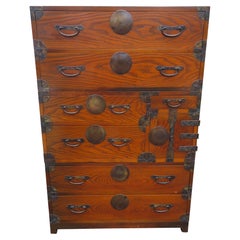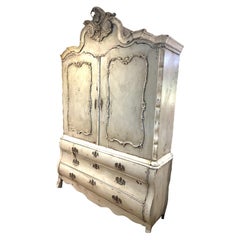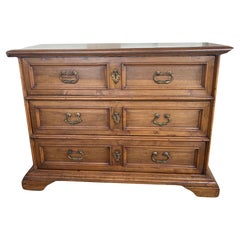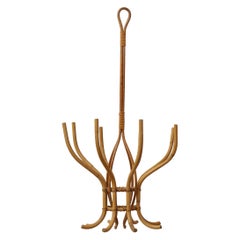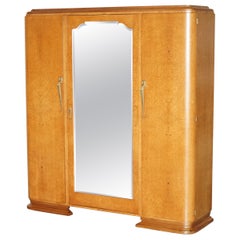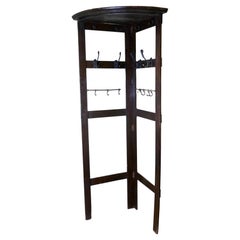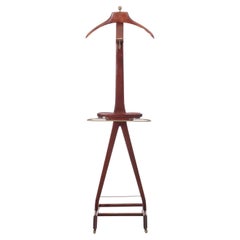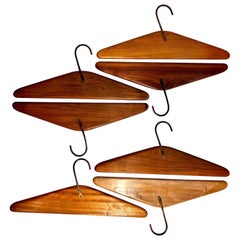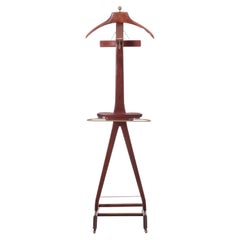Used Clothes Storage
to
21
102
96
112
55
47
30
29
23
18
16
14
11
11
10
8
8
7
7
6
5
3
3
3
3
3
2
2
2
1
1
1
1
1
1
3
3
3
3
3
Sort By
3 Fabulous 20th Century Japanese style Stacking Tansu Chest of Drawers
By Baker Furniture Company
Located in Pemberton, NJ
, obi and accessories, its present-day use works well for clothes storage in the bedroom or linen
Category
Mid-20th Century American Taisho Used Clothes Storage
Materials
Iron
$3,880 Sale Price / set
20% Off
H 85.25 in W 38 in D 18.25 in
Dutch Linen Press Cupboard Armoire
Located in Cranbrook, Kent
.
Available in natural wood if required
Ideal to hide a flat screen or just offering massive clothes storage
Category
18th Century Dutch Dutch Colonial Used Clothes Storage
Materials
Oak
18th Century Tuscan Walnut Commode / Chest of Drawers
Located in Carmine, TX
great as clothes storage in a room, but also in an entryway or office.
Category
Early 18th Century Italian Baroque Used Clothes Storage
Materials
Walnut
1970s French Bamboo Hanging Clothes Rack
Located in Frederiksberg C, DK
Hanging from the ceiling, this French vintage bamboo / rattan hanger is great for night gowns and bathrobes in the bedroom, towels in your bathroom or jackets in your hall. Or anythi...
Category
1970s French Organic Modern Used Clothes Storage
Materials
Bamboo, Rattan
Antique Art Deco Burr Maple Triple Bank circa 1920's Wardrobe Mirrored Door
Located in West Sussex, Pulborough
of folded clothes storage to either side with a large hanging section in the middle, the shelves can
Category
1920s English Art Deco Used Clothes Storage
Materials
Mirror, Maple
$3,814 Sale Price
30% Off
H 78.15 in W 72.25 in D 19.89 in
Folding Clothes Hanging Rack A very unusual piece
Located in Godshill, Isle of Wight
Folding Clothes Hanging Rack
A very unusual piece, this corner standing hanging wardrobe can be
Category
1910s Campaign Used Clothes Storage
Materials
Pine
Mid-Century modern valet clothes by Ico Parisi
By Fratelli Reguitti, Ico Parisi
Located in Courbevoie, FR
Mid-Century modern valet clothes stand designed by Ico Parisi during the 1950s. Manufacturerd in
Category
1950s Italian Used Clothes Storage
Materials
Brass
Carl Auböck II, Clothes Hangers, Austria, c. 1960
By Werkstätte Carl Auböck
Located in Philadelphia, PA
Carl Auböck II, Austria
(7) "rare" Walnut Clothes Hangers, circa 1960
in original condition
Category
1960s Austrian Mid-Century Modern Used Clothes Storage
Materials
Brass
Mid-Century Modern Valet Clothes by Ico Parisi
By Fratelli Reguitti
Located in Courbevoie, FR
Mid-Century Modern valet clothes Stand designed by Ico Parisi during the 1950s. Manufacturerd in
Category
1960s Italian Scandinavian Modern Used Clothes Storage
Materials
Beech
Danish Modern Teak Tambour-Door Clothes Press, 1970s
Located in Chicago, IL
Clean and spacious teak tambour doors linen press or tall chest. There is an upper and lower section with multiple drawers. Seven cubbies and four drawers. Great choice for smaller b...
Category
1970s Danish Mid-Century Modern Used Clothes Storage
Materials
Teak
Large Carl Aubock Midcentury Walnut Ring Clothes Brush, Austria, 1950s
By Werkstätte Carl Auböck
Located in Vienna, AT
A beautiful large ring-shaped modernist wall-hung coat rack clothes brush from the 1950s. Designed
Category
Mid-20th Century Austrian Mid-Century Modern Used Clothes Storage
Materials
Goat Hair, Wood, Walnut
Japanese antique wooden storage shelf/ Early 20th century/Wooden cabinet
Located in Sammu-shi, Chiba
securely fastened and provide ample storage capacity. Books, clothes, daily necessities, and various other
Category
Early 20th Century Japanese Taisho Used Clothes Storage
Materials
Cedar
$2,500
H 66.82 in W 18.9 in D 17.92 in
Wardrobe Coat Rack Clothes Stand Roland Rainer, Vienna, Black Iron Nickel, 1956
By Roland Rainer
Located in Hausmannstätten, AT
This very rare and iconic piece of furniture is one of the most sought after Austrian Post War Designs and has been designed by Roland Rainer the most famous Viennese Midcentury Mode...
Category
1950s Austrian Mid-Century Modern Used Clothes Storage
Materials
Metal, Iron, Nickel
$11,990
H 68.9 in W 59.06 in D 15.75 in
Vintage Jacobean Style English Oak Linen Trunk or Chest for Clothes Toys Etc
Located in West Sussex, Pulborough
Royal House Antiques
Royal House Antiques is delighted to offer for sale this vintage Jacobean style English oak trunk or chest.
A very good looking and well-made piece, ideall...
Category
20th Century English Jacobean Used Clothes Storage
Materials
Oak
$524 Sale Price
30% Off
H 21.26 in W 37.6 in D 18.71 in
LOVELY CHiNESE ELM STORAGE TRUNK OR CHEST OF LINEN & CLOTHES, TOYS OR FOR A BIN
Located in West Sussex, Pulborough
with brass strap work storage trunk or little chest
Please note the delivery fee listed is just a
Category
20th Century Chinese Export Used Clothes Storage
Materials
Elm
$866 Sale Price
20% Off
H 18.71 in W 13 in D 13 in
LOVELY CHiNESE ELM STORAGE TRUNK OR CHEST OF LINEN & CLOTHES, TOYS PART OF A SET
Located in West Sussex, Pulborough
with brass strap work storage trunk
Please note the delivery fee listed is just a guide, it covers
Category
20th Century English Chinese Export Used Clothes Storage
Materials
Elm
$1,084 Sale Price
20% Off
H 20.87 in W 34.85 in D 19.69 in
Modern Campaign Style Oak Gentlemen’s Chest by Founders Furniture Patterns 35
By Founders Furniture Company
Located in Topeka, KS
beading. It’s a lovely detail! This modern beauty has ample storage for linens, clothes, towels, or any
Category
Mid-20th Century American Campaign Used Clothes Storage
Materials
Brass
$2,495
H 54.25 in W 36 in D 19 in
Swedish hand painted 19th century pine cupboard
Located in Debenham, Suffolk
shelves to provide plenty of storage for clothes or bed linens, could also be used in the kitchen as a
Category
Late 18th Century Swedish Gustavian Used Clothes Storage
Materials
Pine, Paint
Vintage Sideboard, Mid Century, Unique Dresser, Cabinet, 9 Drawers, Buffet
Located in Rancho Cucamonga, CA
plentiful storage for clothes, linens, files, or collectibles.
Contact us if you would like more pictures
Category
Mid-20th Century Unknown Mid-Century Modern Used Clothes Storage
Materials
Laminate, Wood
$6,500
H 42.25 in W 92 in D 17.75 in
Edward Wormley Cerused Oak Cabinet for Dunbar, 1950s USA
By Edward Wormley, Dunbar Furniture
Located in Los Angeles, CA
storage location for clothes, shoes, bags, blankets, toys, or anything in your home that you may want to
Category
1950s American Used Clothes Storage
Materials
Leather, Oak
Dresser with Mirror Made In Teak, Danish design From 1960s
Located in Lejre, DK
two large drawers and three smaller drawers, it offers ample storage space for clothes, jewelery and
Category
1960s Danish Mid-Century Modern Used Clothes Storage
Materials
Teak
$2,323 Sale Price
20% Off
H 43.71 in W 30.71 in D 15.36 in
Chinese Red Lacquer Coffer with Gilt Carvings, c. 1900
Located in Chicago, IL
ancestor worship and as a storage cabinet for clothes, textiles, and other household items. The large
Category
Early 20th Century Chinese Qing Used Clothes Storage
Materials
Cypress, Lacquer
Hand-Made Tall Armoire Made in France, Early 1900s
Located in Los Angeles, CA
. The armoire also has several drawers and ample storage space for clothes, accessories, and other
Category
1920s French Victorian Used Clothes Storage
Materials
Fruitwood
Antique Oak Iron Large Silver Chest Downton Abbey Highclere Castle C.F. Hancock
By C. F. Hancock
Located in Portland, OR
chest would make excellent storage for bedding, clothes, or anything you chose?
Category
Mid-19th Century English Early Victorian Used Clothes Storage
Materials
Iron
$3,600
H 32.25 in W 34.25 in D 24.25 in
Georgian Mahogany Linen Press
Located in Bedfordshire, GB
&
replaced with a hanging rail to allow storage of clothes on hangers
which is more in keeping with modern
Category
Mid-18th Century English George III Used Clothes Storage
Materials
Mahogany
1980s Mirrored Armoire
By Ello Furniture
Located in Denton, TX
1980s mirrored armoire with brass accents in the style of Ello. Giant storage space for clothes
Category
Mid-20th Century American Modern Used Clothes Storage
Materials
Mirror, Wood
Bamboo/Rattan and Brass Wardrobe by Dal Vera, Italy, 1970s
By Franca Helg, Antonio Piva and Franco Albini, Vittorio Bonacina, Dal Vera
Located in Kaštel Sućurac, Splitsko-dalmatinska županija
features double-opening doors that lead to a spacious interior with ample room for hanging clothes
Category
1970s Italian Mid-Century Modern Used Clothes Storage
Materials
Brass
Antique William IV Compactum Wardrobe
Located in London, GB
a very large item with lots of storage space for clothes.
Width – 88 inches , 222 cm
Depth – 24
Category
1830s English William IV Used Clothes Storage
Materials
Wood
French 19th Century Faux Bamboo Vanity
Located in Baton Rouge, LA
in the chest–outlined in the same faux bamboo trim as elsewhere–offer storage for clothes, cosmetics
Category
19th Century French French Provincial Used Clothes Storage
Materials
Marble
Antique Rustic Portuguese Chest of Drawers
Located in Lisboa, Lisboa
offers ample storage capacity for clothes, textiles or personal belongings, and the crafted metal handles
Category
20th Century Portuguese Mid-Century Modern Used Clothes Storage
Materials
Marble, Brass
French 18th Century Louis XVI Period Commode
Located in Baton Rouge, LA
storage for clothes, linens, or other household essentials. Fluting on the corners of the case flows into
Category
18th Century French Louis XVI Used Clothes Storage
Materials
Marble, Brass
French 19th Century Louis XVI Style Commode
Located in Baton Rouge, LA
elegant storage for clothes, linens, or other household essentials. Fluting on the corners of the case
Category
19th Century French Louis XVI Used Clothes Storage
Materials
Marble, Brass
Danish Teak Chest of Drawers by Dyrlund, Mid-Century Scandinavian Design
By Dyrlund
Located in Wiesbaden, DE
, providing ample storage space for clothes, linens, or other personal items. The teak finish in a warm, brown
Category
1970s Danish Scandinavian Modern Used Clothes Storage
Materials
Teak
$3,141
H 42.52 in W 39.38 in D 19.69 in
Chinese Playful Wisdom Coffer, c. 1850
Located in Chicago, IL
and as a storage cabinet for clothes, textiles, and other household items. The impressive sideboard
Category
Mid-19th Century Chinese Qing Used Clothes Storage
Materials
Brass
Antique 19th Century Black Forest Antler Horn Sofa, Swiss/German c.1890
Located in Royal Tunbridge Wells, Kent
source material for clothes hooks, storage racks and chandeliers, the so-called "lusterweibchen
Category
19th Century German Black Forest Used Clothes Storage
Materials
Antler, Fabric
$4,763
H 40.16 in W 58.67 in D 26.38 in
Hunting trophy chair wild boar , Antler, Red Deer, Fallow, animal skin, 1970s
Located in Zevenaar, NL
material for clothes hooks, storage racks and lamps since the 15th century. Mounting antlers and stuffed
Category
20th Century Polish Black Forest Used Clothes Storage
Materials
Antler, Animal Skin
$5,640 Sale Price
44% Off
H 57.49 in W 53.15 in D 37.41 in
Vintage Italian travel trunk cabinet brass and leather
Located in Milano, IT
opening canvas flap, where inside we notice a complete metal clothes hanger element, and a storage holder
Category
1910s Italian Used Clothes Storage
$2,371 Sale Price
20% Off
H 55.12 in W 22.45 in D 23.82 in L 55.12 in
Armchair, Pair, Hunting Trophy, Antler, Red Deer, Fallow, Wild Boar, Hide
Located in BUNGAY, SUFFOLK
beautiful forms in nature…” Gail Flynn
Hunting trophies have been used as source material for clothes
Category
Late 19th Century European Victorian Used Clothes Storage
Materials
Antler, Hide
$24,532 / set
H 51.97 in W 35.83 in D 37.8 in
Vintage Bespoke Clothes Storage Unit by Paul Connell, 1980s
Located in Chesham, GB
Made by Connell whilst at Parnham House and shown at the Royal Agricultural Show in Stonleigh.
It was also included in an exhibition at the Barbican Centre during the 1980s.
Desi...
Category
1980s Used Clothes Storage
Materials
Fabric, Wood
Song Dynasty Storage Cabinet
Located in Atlanta, GA
This Song Dynasty storage cabinet was typically used in a home for clothes storage. Traditional
Category
19th Century Chinese Used Clothes Storage
Three Level Kiriwood Tansu
Located in New York, NY
Multi-level Japanese Tansu with drawers, cabinets and sliding shelves. Excellent for clothes
Category
Early 20th Century Japanese Used Clothes Storage
Three Level Kiriwood Tansu
Located in Brooklyn, NY
Multi-level Japanese tansu with drawers, cabinets and sliding shelves. Excellent for clothes
Category
Early 20th Century Japanese Used Clothes Storage
Chinese Clothes Cabinet
Located in Atlanta, GA
This piece, out of the Fujian Province, was originally a clothes cabinet from the southern region
Category
Chinese Used Clothes Storage
Materials
Wood
Pace Collection Valet and Full-Length Mirror
By Pace Collection, Guido Faleschini
Located in San Diego, CA
clothes storage and has a full length mirror on the front.
Category
20th Century Italian Used Clothes Storage
Materials
Stainless Steel, Chrome
Teak Clothes Hooks, 1960s
Located in Freiburg, DE
This clothes hanger is made of teak.
Category
1960s German Mid-Century Modern Used Clothes Storage
Materials
Teak
Superb Early 19th Century Anglo Chinese Camphor Wood Campaign Secretaire Chest
Located in Suffolk, GB
for clothes storage as the camphor wood scent is good for keeping moths away.
Size:
Height 41.75
Category
Early 19th Century Chinese Used Clothes Storage
Materials
Wood
$11,584
H 41.75 in W 38.25 in D 21 in
English Serpentine Front Clothes Press
Located in Stamford, CT
An 18th century English Mahogany serpentine front two door clothes press having four shelves and
Category
18th Century and Earlier English Used Clothes Storage
Unusual Regency Mahogany Dwarf Clothes Press
Located in London, GB
Unusual Regency mahogany dwarf clothes press, circa 1810.
Category
Early 19th Century Used Clothes Storage
Early 20th Century Double Clothes Hanger, 1900s
Located in Milan, Italy
This double coat hanger is completely made by iron and it come from the early 1900. It has 12 hooks each sides, it is in its original patina that is mainly on the color of green. To ...
Category
Early 20th Century Italian Used Clothes Storage
Materials
Metal
Late 18th. Century Mahogany Linen (Clothes) Press, c. 1790
Located in Atlanta, GA
A Handsome and Tall 18th century Mahogany Inlaid Linen Press with Ogee bracket feet, c. 1790
Category
18th Century and Earlier English Used Clothes Storage
Materials
Brass
Oak Wardrobe / Clothes Press, Charles II period, Lancashire, circa 1670-1680
Located in Matlock, Derbyshire
Small Charles II oak wardrobe or clothes press, Lancashire, circa 1670 - 1680.
The panelled
Category
17th Century British Charles II Used Clothes Storage
Materials
Oak
$13,424
H 53 in W 46 in D 19 in
Remarkable French Walnut 19th Century Armoire, That Is a Clothes Closet
Located in West Palm Beach, FL
has one top fabric covered fixed shelf with a clothes hanging steel bar, with a covered fabric sides
Category
Early 19th Century French French Provincial Used Clothes Storage
Materials
Walnut
$7,912
H 92 in W 57 in D 22.5 in
Large Teak Cabinet or Wardrobe by Børge Mogensen, Scandinavian Modern
By Børge Mogensen
Located in Houston, TX
work great in any room of the house - organizing papers in the office, additional storage for folded
Category
1960s Danish Scandinavian Modern Used Clothes Storage
Materials
Teak
$4,250
H 58 in W 47.25 in D 15.75 in
19th Century Armoire For A Girl
Located in Lučenec, SK
made. It provides ample storage for clothes or underwear. The color theme also highlights it's girly
Category
1890s Austrian Late Victorian Used Clothes Storage
Materials
Pine
Art Deco Walnut Figured Two-Door Wardrobe or Armoire with Original Fittings
Located in High Wycombe, Buckinghamshire
. Pull out bar for hanging clothes, separate storage compartments for shoes, clothes and tie and belt
Category
1930s European Art Deco Used Clothes Storage
Materials
Bakelite, Walnut
$2,289
H 60.04 in W 35.83 in D 18.12 in
Vintage Danish Pine Armoire, Pantry or Media Cabinet
Located in Chicago, IL
plates & turned wooden pulls. Provides great storage for clothes or linens in a bedroom or bath, or as a
Category
20th Century Dutch Country Used Clothes Storage
Materials
Pine
Louis Vuitton Wardrobe Leather Trunk 8 Trays 1909-1914
By Louis Vuitton
Located in Haguenau, FR
storage)
- In trunk shoe (minimum 2 pairs per drawer and more)
- In trunk jewelry
- In trunk clothes
Category
20th Century French Edwardian Used Clothes Storage
Elegant vintage wardrobe from Novy Domov, 1970´s, Czechoslovakia
By Novy Domov
Located in Prague 8, CZ
1970´s. Inside there is one clothes rail and storage space. The inner shelf is missing from the photos
Category
Late 20th Century Czech Mid-Century Modern Used Clothes Storage
Materials
Wood, Ash, Plywood
$1,108
H 67.72 in W 43.31 in D 23.63 in
- 1
Get Updated with New Arrivals
Save "Used Clothes Storage", and we’ll notify you when there are new listings in this category.
Used Clothes Storage For Sale on 1stDibs
With a vast inventory of beautiful furniture at 1stDibs, we’ve got just the piece of used clothes storage you’re looking for. Frequently made of wood, metal and brass, every item from our selection of used clothes storage was constructed with great care. You’ve searched high and low for the perfect choice in our collection of used clothes storage — we have versions that date back to the 18th Century alongside those produced as recently as the 20th Century are available. Each object in our assortment of used clothes storage bearing Mid-Century Modern, Georgian or Regency hallmarks is very popular. You’ll likely find more than one option in this array of used clothes storage that is appealing in its simplicity, but Anna Castelli Ferrieri, Carl Auböck and Kartell produced versions that are worth a look.
How Much is a Used Clothes Storage?
The average selling price for a piece of used clothes storage at 1stDibs is $5,666, while they’re typically $215 on the low end and $125,000 for the highest priced.
Questions About Used Clothes Storage
- What is raffia cloth used for?1 Answer1stDibs ExpertApril 5, 2022Raffia cloth is used to produce many different types of items. Examples include clothing, handbags, placemats and upholstery. The cloth comes from dried woven palm leaves. You can find a variety of raffia cloth furniture, apparel and decorative objects on 1stDibs.
- What is a tapa cloth used for?1 Answer1stDibs ExpertApril 5, 2022Tapa cloth is a textile used to create garments, as well as for bedding and wall hangings. Artisans make it out of dried bark rather than yarn. Indigenous people in the Pacific Islands produce various types of tapa cloth. Shop a collection of tapa cloth on 1stDibs.
- 1stDibs ExpertApril 5, 2022Emilio Pucci’s famous ski clothes used a signature fabric, dubbed “Emilioform,” which was developed in 1960. A special blend of shantung silk and nylon, it was designed to be aerodynamic and took the world by storm. Shop a wide collection of expertly-vetted Emilio Pucci clothing and accessories from some of the world’s top sellers on 1stDibs.
More Ways To Browse
American Of Martinsville Lowboy Dresser
Kimono Cabinet
Louis Xv Bonnetiere
Vintage Locker Cabinet
Antique Bakery Display Case
Baker Tansu
Bombe Armoire
Paolo Buffa Wardrobe
Vintage Linen Closet
9 Foot Sideboard
Berkey And Gay Buffet
Chin Hua Buffet
Chin Hua Dresser
Floral Painted Alpine Wardrobe
Marian Grabinski
Spanish Sacristy Cabinet
Used Sports Lockers
Zebrano Chair
